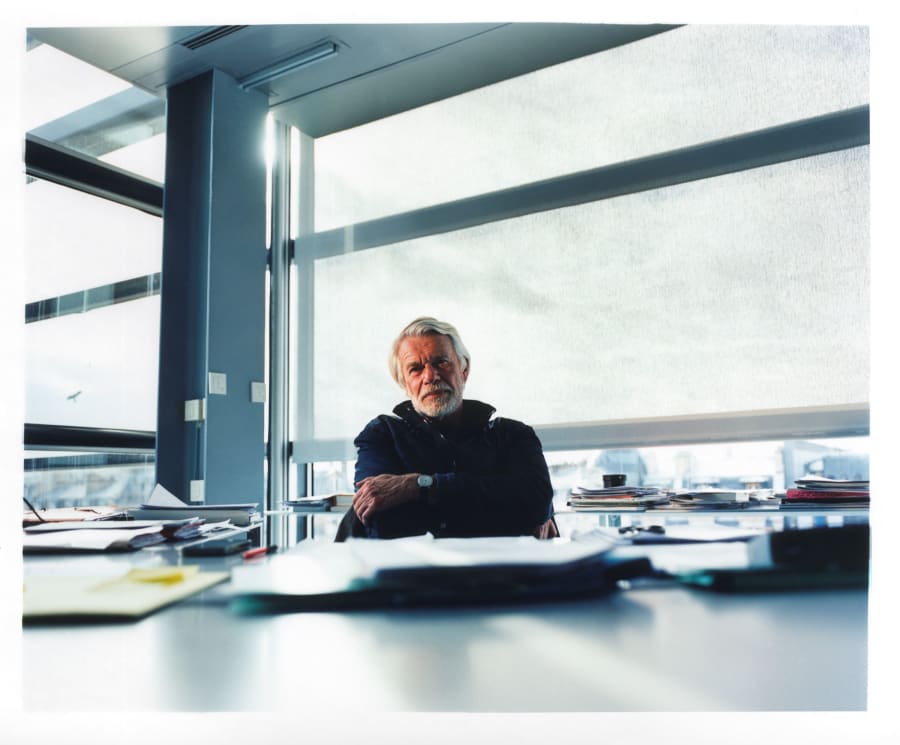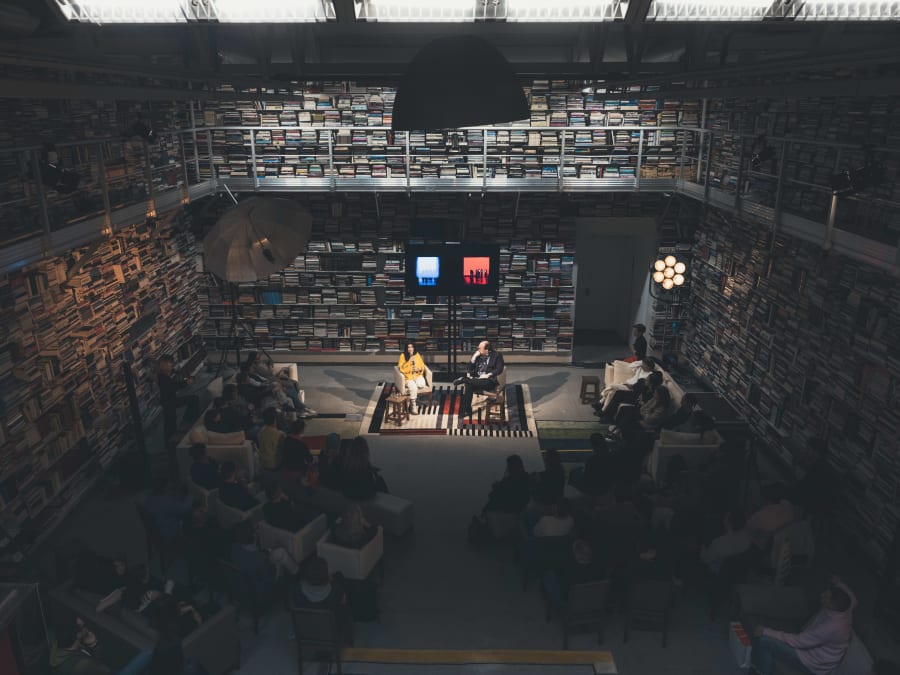The term ‘Arab’ is still often used as a catchall to encompass what is a multitude of very different cultures and histories. At a time when xenophobic ideologies appear to be proliferating in France, and in many parts of Europe and beyond, how are contemporary Arab artists navigating what ‘Arab’ means? On the occasion of the exhibition ‘ARABOFUTURS: Science fiction and new imaginations’ at the Institut du monde arabe (IMA) in Paris, on view until October 27 2024, Art Basel met with artists who, are exploring the layers of Arab identity, probing tradition while also breaking conventions, and unpacking different symbols and myths of the Arab world.
Born in 1996 in France to a Lebanese mother and Palestinian father, Rayan Yasmineh spent part of his childhood and adolescence in Jordan. Graduating from the Beaux-Arts de Paris in 2022, the artist is represented by the Parisian gallery mor charpentier. The architecture, colors, objects, landscapes, characters – all the elements present in Yasmineh’s paintings recall various countries and cultures, from across Arab, Persian, and Western worlds. Created with impressive meticulousness, many of his works resemble perfectly lit photographs.
But the most intriguing thing about Yasmineh’s work are his deliberate anachronisms. In The flower of Damascus and Abdelkader (2023), the artist replaces the figure of the 19th-century Algerian emir Abdelkader – the man who led the struggle against the French colonial invasion of Algiers – with one of his friends, who happens to share the same name, also of Algerian origin. Instead of the keffiyeh, the friend poses in a Lacoste jacket, with an Algerian soccer shirt over his shoulder. Yasmineh does something similar in his Self-portrait with turban and Adidas jacket, get up Jerusalem (2019). ‘I’m of Arab origin, and my parents’ apartment is full of references to this identity,’ Yasmineh says. ‘We speak a lot of Arabic at home, so it’s something that’s part of my reality. For me, Arab culture is just a principle of reality, like Western culture, and in fact, in my work, there are many allusions to both.’ He sees his work as ‘part of a dialog,’ Yasmineh says. ‘It’s important to remember this at a time when there is more and more identity-based discourse insisting on difference rather than unity.’
Mounir Ayache, a French-Moroccan artist based in Marseille, was born in 1991. His work was deeply inspired by Leo Africanus, the Renaissance-era Andalusian diplomat and geographer who converted from Islam to Christianity then back to Islam. Ayache’s work at the IMA includes a video game, sculptures, and digital prints that immerse the audience in an imaginary journey undertaken by Leo Africanus. ‘It’s a way of talking about contemporary times through a hypothetical projection into the future, using a bit of humor and the codes of science fiction,’ Ayache says.
‘When I read Leo Africanus [the 1986 novel about the man by Amin Maalouf], I felt this sensation of heroism, like when I watch The Lord of the Rings, but for once, the hero was Arab. I could identify with him.’ Ayache also recounts how, when he began to integrate the question of his origins into his work, he had the impression that he was only seeing sad things. ‘So I said to myself, there were enough artists denouncing what was wrong; I wanted this culture to project itself into the future, saying that things would be better later on.’
It was during his studies at the Beaux-Arts de Paris that he initiated this approach. ‘I was asked to give substance to my work, but I felt I had nothing important to say. That’s when I started to take a renewed interest in my native culture, which you’re asked to forget when you grow up in France,’ Ayache confides.
For the artist, working with figures such as Leon the African, whose destiny is as exceptional as it is mysterious, also serves to highlight an Arab identity that is as complex as it is differentiated - a far cry from the preconceived ideas and simplistic fantasies that continue to haunt certain Western imaginations.These multiple identities are echoed in a wide variety of creative practices. Based in the Paris suburbs, the tattoo artist Aïda specializes in the symbols of the Amazigh (‘free men’), as the Berbers call themselves. A pre-Islamic custom, Berber tattoos, applied to the face, include lines, triangles, and other geometric shapes, symbolizing periods of transition and connections to land. 90% of Aïda's customers are women. ‘They come looking to reconnect,’ she says. ‘They often mention a grandmother who pampered them when they were little, but who didn’t tell them about her tattoos. They bring me photos where, in most cases, I can translate [the tattoos]. The wonderful thing is that I get to tell the grandmother’s story to her granddaughter.’
Born to a French mother and Tunisian father, Aïda grew up with both cultures, and never felt forced to choose. ‘There was no question, we were both,’ she says. In 2014, shortly after the end of the Arab Spring, the artist decided to study anthropology ‘to lift the taboo on the tattoo worn by my great-grandmother and my grandmother’s sisters.’ Indeed, Berber tattoos have gradually disappeared since the second half of the 20th century. With tattoos considered haram by Islam, most families have stopped passing on this ancestral custom. Aïda is trying to change this. ‘If I can ensure that tomorrow’s grandmothers are tattooed like our great-grandmothers and grandmothers, I’d be very happy,’ she says.
Tunisian artist Nicène Kossentini is also preoccupied by the fear of disappearance. Born in 1976, Kossentini grew up in the eastern Tunisian port city of Sfax. After graduating from the Beaux-Arts de Tunis, she moved to France to pursue her studies. While obtaining her doctorate in plastic arts in Paris, she decided to work with the landscapes that are gradually disappearing in Tunisia: stretches of sand as well as the country’s unique salt lakes. After her studies, Kossentini decided to return to Tunis, where she now lives and works.
In her 'Boujmal' series, Kossentini superimposes family photos with shots of the salt lake in Sfax, as well as verses from Arabic poems. Her artworks are minimal, often black and white. It was while traveling back and forth between France and Tunisia that Kossentini began to perceive ‘a slow disappearance of landmarks’ from her childhood, ‘such as the architecture or the way of speaking,’ she says. Kossentini also decided, for one of her projects, to record her grandmother telling stories, ‘because [the role of storyteller] almost doesn’t exist anymore in our society.’
As for her return to Tunis, it seemed totally natural, and she couldn’t see herself continuing her creative process in France. ‘I wasn’t inspired. For me, it’s very important to be in my own universe, and in France, I was a stranger,’ she explains. ‘I felt exiled there in the artistic sense of the word, in my thinking.’
Despite these artists' diverse creative approaches, their practices seem to tend towards a common goal: to illustrate a history and culture that disregards the simplistic equations associated with the Arab world. They highlight not only the themes that link them to the present moment, but also the beauty and joy of the heritage they carry.
Noujoud Rejbi is an author and podcaster based in Paris.
Caption for top image: Mounir Ayache, Una linea storta tesa, 2023. Photography by Daniele Molajoli.
Published on May 27, 2024.


